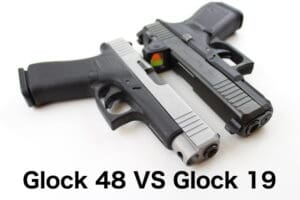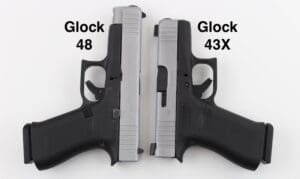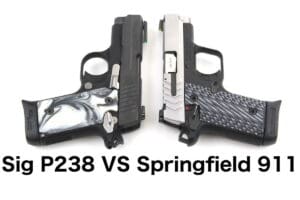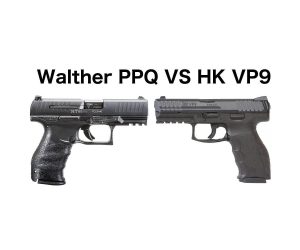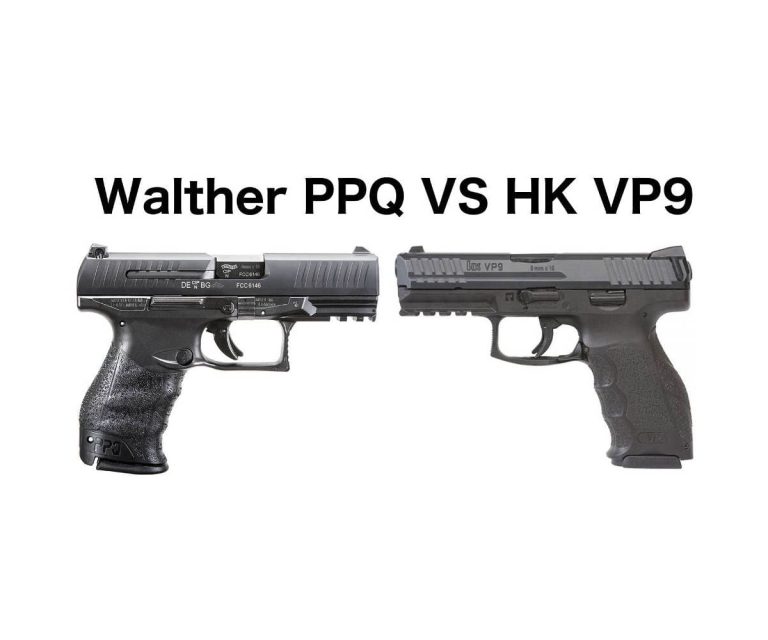
Walther PPQ vs HK VP9 (with pictures)
Walther PPQ vs HK VP9
A Detailed Review
The world is filled with plastic fantastics. Plastic fantastic is an often affectionate name given to polymer frame, double stack, striker-fired guns that are usually 9mm, but 40 S&W also qualifies. What started with the success of Glock has become the success of the entire industry. Every company who’s a serious contender produces some form of plastic fantastic, including HK and Walther and their great models between the Walther PPQ vs HK VP9.
These European heavyweights are immensely popular companies that both have a reputation for quality firearms that feature a level of refinement above their competition.
Both also produce or have produced a wide variety of striker-fired firearms. The striker-fired flagships of HK is the VP9 and Walther’s flagship is the PPQ.
Both guns have proven to be fantastic weapons, and as pistols, they are on a different level than most striker-fired, polymer-framed, handguns.
The HK VP9
For some time the famed German firm Heckler and Koch did not produce a striker-fired pistol. In the 80s and 90s, they were big fans of the concept and invented the first polymer frame striker-fired pistol.
However, they dived into the more successful DA/SA market for an extended period of time. The introduction of the VP9 took the gun market by storm, and the low relative price was immensely attractive to HK fans and new shooters.
Immediately the gun was embraced by the gun-buying public. It became an instant hit, and the market welcomed the VP9 with open arms. German police forces adopted the VP9, Luxembourg police forces, and even a number of US police departments have adopted the gun or approved it for duty use.
Of course, as the people’s pistol and civilians have widely adopted it with a sweet tooth for striker-fired HKs.
The VP in VP9 stands for Volkspistole, which means the people’s pistol. The price and simple design make it a gun most people can shoot with ease and can afford.
The VP9 holds 15 rounds of 9mm and sports an ambidextrous magazine release, interchangeable grip panels, an accessory rail, and no manual safety.
The VP9 series has expanded into the VP40 in 40 S&W, and the VP9SK, a compact model of the VP series, and the VP9 Tactical with a threaded barrel and suppressor height sights.
Walther PPQ
Walther is often the name synonymous with James Bond and the PPK. If you were to say the words, “I have a Walther,” most people assume the PPK. However, the PPK is a bit outdated for a duty pistol, and Walther has kept themselves up to date.
The PPQ is the current flagship Walther design and is meant for police use, concealed carry, and home defense.
The Walther was based on the P99QA, but it eliminated the double-action portion of that design. This partially cocked single action striker is simpler and more comparable to most modern striker-fired guns. Additionally the gun sports a re-designed grip, trigger guide and slide.
The gun is well known for its impressive ergonomics and the comfort most users feel when gripping the gun. The Walther PPQ has become a favorite competition pistol due to its reliability, trigger, and ergonomics. It’s an extremely well-made gun with a reputation for refinement of fit and finish.
PPQ stands for Police Pistol Quick Defense, and this is in reference to the trigger design being single action only.
The PPQ holds 15 rounds of 9mm and has interchangeable backstraps, and comes in M1 and M2 models. The M1 features a paddle magazine release and the M2 features a reversible button release.
The PPQ series comes in 9mm, 40 S&W, 45 ACP, and 22 LR. There is the standard model, as well as the sub-compact. The gun also comes in barrel lengths ranging from 4, 4.2, 4.6, and 5-inch models. Some wear extended barrels for competition and others to attach a suppressor to it.
Walther PPQ vs HK VP9: Fit and Finish
Both the PPQ and VP9 are made to be working guns. These are the guns you’ll find in the Walther PPQ holsters and HK VP9 Holster of cops and soldiers, so they are prepared for practical purposes. That being said both features a tough Tennifer finish so you won’t have to worry about the Walther PPQ vs HK VP9 in this instance.
Tennifer is insanely resistant to saltwater and corrosion in general. It’s a durable finish that has no problems with sweat, saltwater, or resisting scratches and scraping. It gives the end-user a matte black look.
HK does take it a step further with their Hostile Environment finish that lays down a polymer coating with the Tennifer. This makes it less prone to gouges, scrapes, and scratches.
Outside of the functional nature of these weapons, both guns look great. The finish is applied evenly and gives these guns an overall smooth finish. HK and Walther both pride themselves on not cutting corners and these guns show it.
The VP9 is more angles and rectangles, and the PPQ is rounder around the edges. Both guns have tasteful roll marks displaying both the name of the company and the model of the pistol. Walther’s scroll has always been the gold standard as far as I am concerned.
The guns both have unique, eye-pleasing grip stippling, as well as clean-cut serrations in the slide. The weapons are both refined and well made. This means everything locks into place with little to zero play, and the parts are slop free.
HK has a slight advantage with their poly coat, but both guns look and feel great.
Walther PPQ vs HK VP9: Specs
The HK VP9 sports a 4.09-inch barrel, with a total length of 7.34 inches. The gun is 5.41 inches tall, and 1.32 inches wide. It rocks a 15 round magazine and weight 25.56 ounces with an empty magazine.
The VP9 uses the same magazine as the hammer-fired P30, so magazines are widely available. The HK VP9 comes with both front and rear slide serrations, a Picatinny rail for accessories, and a wide variety of side, front, and rear grip panels to adjust the gun to your hand.
The bore has polygonal rifling with six grooves in a right-hand twist. The barrel is cold hammer-forged and made from cannon grade steel. It will last forever, if not forever, longer than you.
The Walther PPQ M2 has a 4-inch barrel and an overall length of 7.1 inches. The gun is 5.3 inches tall, and 1.3 inches wide. It fires from a 15 round magazine that is compatible with the older P99 magazines. The gun weighs 24.5 ounces empty and also sports rear and front slide serrations.
The gun has three interchangeable backstraps for different grip sizes. The barrel is also cold hammer forged and utilizes polygonal rifling.
If you were just to read the specs, the two guns seem to be twins. They are quite similar, and when two companies are trying to produce an affordable, well-made weapon that fulfills specific roles, then you can bet there will be overlap.
Walther PPQ vs HK VP9: Ergonomics
Here is where battles can be won and lost in the gun world. How does a pistol feel? How do the controls work? These are all critical questions, and often the winner is which one feels better in your hand.
We’ll talk objective facts, but at the end of the day when you pick the gun up is when you figure out if it fits you.
Both guns do feature overtly ambidextrous controls. The PPQ M1 or “Classic” sports the same paddle release as the VP9 which is inherently ambidextrous. On top of that, both guns wear ambidextrous slide releases. Neither gun has a manual safety, and they both have trigger-based safeties.
The PPQ M2 has an American style push-button magazine release, and it can be moved to the left or right-hand side. It’s not genuinely ambidextrous, but configurable for any user.
HK just released the VP9-B which also features a button release that is reversible. Speaking of configuration, the guns both feature customizable grips.
The PPQ comes with three backstraps to adjust the gun to different hand sizes. The VP9 goes a step further and gives you three backstraps and six grip panels for an impressive degree of customization.
The slide release on the Walther PPQ is one of my favorites. First off, its massive and easy to reach and use with bare hands or while wearing gloves. It’s also positioned so that a high, thumbs forward grip won’t disable the slide lock. The HK VP9 gives me the same problems SIG’s do, and that’s my thumbs resting on top of the slide lock instead of alongside it. This prevents the gun from locking back on the final round.
As mentioned before both feature front and rear slide serrations. The VP9 does have wings. By wings, I mean raised portions on the rear of the slide. These provide a better grip and make the gun easier to rack. This can be invaluable for those who have terrible hand strength.
The way a gun feels in hand is the most subjective thing there is. To me, the Walther PPQ sets the bar for comfortable handguns. Its grip fits me perfectly, and I find it immensely satisfying. That being said the VP9 grip is excellent, I have no specific complaints about it. I merely like the PPQ a bit more.
Both companies place a lot of time into making a comfortable grip that allows a high hold on your gun.
Both guns have a nice trigger undercut, a great beavertail, and nice palm swell.
Walther PPQ vs HK VP9: Features
Both the VP9 and PPQ have Picatinny rails for lights, lasers, coffee makers and other accessories. The guns also feature full-sized sights with standard three-dot and night sight options available depending on the model.
HK Produces the VP9 in black, FDE, OD Green, and grey. The PPQ is produced in black, OD Green, Tungsten, FDE.
I do like the fact the grip panels on the PPQ are black, and I think it offsets and looks excellent with the FDE, OD Green, and Tungsten models.
The VP9 has an enlarged heavy-duty extractor that functions as a loaded chamber indicator which is a nice feature. The PPQ does come standard with an adjustable rear sight for zeroing purposes.
Walther PPQ vs HK VP9: Shooting Characteristics
These guns both handle amazingly well. The high grip you can achieve helps fight recoil and muzzle rise. Both guns sport light striker-fired triggers that make double taps and rapid-fire easy and controllable.
The trigger on the Walther PPQ is likely the greatest stock trigger ever placed on a striker-fired handgun. It’s light, short, creep and grit-free. It can easily take you by surprise and make something like a Glock trigger feel immensely heavy. Its 0.1” trigger reset is brilliant.
The VP9 trigger is a little stiffer, but not by much. It’s smooth and grit-free, it just requires about 1.5 pounds more pull than the PPQ. The VP9 trigger is refined and comes in second place concerning stock triggers, and striker-fired guns.
Both guns have nice combat style sights that make getting on target easy, and accuracy is top-notch. You can almost split hairs with these guns. The sights, the triggers, the grip are all aligned to bring the most accuracy you can squeeze out of their hammer-forged barrels.
Walther PPQ vs HK VP9: Ease of Concealment
These are both full-sized guns, but with the right holster, they can be concealed carried comfortably. The Walther’s rounder edges may feel more comfortable when it comes to IWB options.
Concealing IWB may be slightly uncomfortable, and will likely require you to go up a size in pants. Concealing OWB will be more comfortable, but it may be harder to hide the gun.
The V3 No Print Wonder lets you figure out which works well for you by allowing you to choose OWB, Appendix, or traditional IWB.
Since they are double-stack guns if you were looking to carry an extra magazine, the Mag holster is likely your best bet. It’s supportive of those 15 rounds of 9mm.
Final Thoughts
I love living in America because I don’t have to pick and choose what gun I want. As long as I have the funds, I can purchase both. However, if I could only have one which way would the cookie crumble?
Honestly, I’d go with the PPQ M1 or Classic model. I prefer the paddle release over a button. That being said the HK Vp9 is an outstanding gun, and I wouldn’t feel under-gunned with it.
What do you folks think between the Walther PPQ vs HK VP9? Let us know which model you would choose and why. If you are also looking for a dedicated Kydex holster to secure your concealed carry handgun inside, we recommend you check out our concealed carry holster here.









